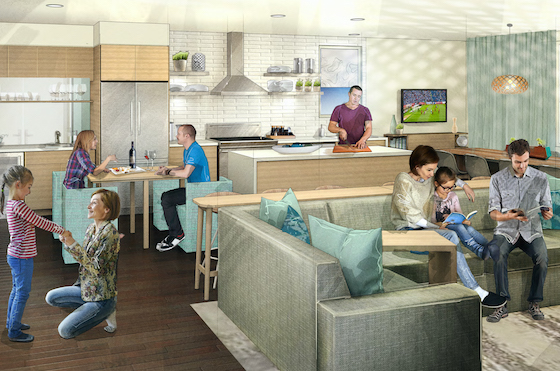The communal living trend is heading into the extended-stay space. Marriott International announced in January that its extended-stay Element brand would cluster four guestrooms around a communal living room with couches, an eight-seat dining area and kitchenette.
The new design doesn’t change Element’s prototype – it simply shrinks the size of the guestrooms in the communal area, says Toni Stoekl, Marriott’s global brand leader of lifestyle brands. The communal room groups will be located at the end of the corridor, with slightly smaller guest rooms others in the design, he said.
And while it was conceived with business associates in mind, some of the most positive feedback on the concept has come from leisure travelers – think families in town for a reunion who want to stay together but need extra space to relax.

“We looked at why people travel in groups and what they might need,” Stoekl said. “The thought was, can we provide an opportunity for business and leisure?… You can have privacy when you want it and the sense of community when you want it.”
The brand, which has more than 20 hotels open and more than 70 in the pipeline, expects to announce the first project incorporating the design within the next couple of months, “probably in the U.S.,” Stoekl said.
Three of the four rooms have doors that open to a corridor; only one opens directly into the communal space, which allows flexibility when occupancy is high and doesn’t force strangers to hang out with each other in the common area if they don’t want to.
Do hotels compromise on revenue with special-use spaces like this? Not necessarily, said Tom Sprinkle, principal at HKS Hospitality Group. “Groups traveling together who are interested in having a shared space would likely pay a premium for it.”
But design is key: “The FF&E components are really important,” Sprinkle said. “It shouldn’t feel like it’s an afterthought or simply a different configuration of the guestroom, or a place to get work done with a table, lamp and a couple of chairs thrown in. Everyone will retreat to the lobby if the room isn’t special enough to want to hang out. It should be comfortable yet functional, set up to accommodate meal catering or cooking or a group of work colleagues who want to spread out their stuff and practice a presentation.”
He added, “Attractive technology is a must – flat screen TV, a great sound system and a device to listen to your own playlist. In business hotels, items you didn’t bring from the office would be cool – an easel, white board or flip chart, office supplies. The space should be accessible to housekeeping but secure so guests can leave their things out.”
While the communal area isn’t unknown in the resort space, such as leisure travelers or golf foursomes renting guest room suites, evolving the concept to an urban hotel setting is “something different,” Sprinkle said. “Urban and extended stay would be particularly adept to communal space if designed well – programmatically, it make sense to think long term about the layout so it’s flexible enough to convert to a guestroom or other amenity space in the future.”
